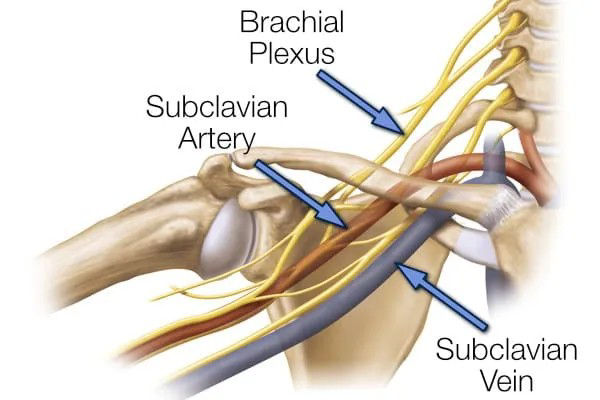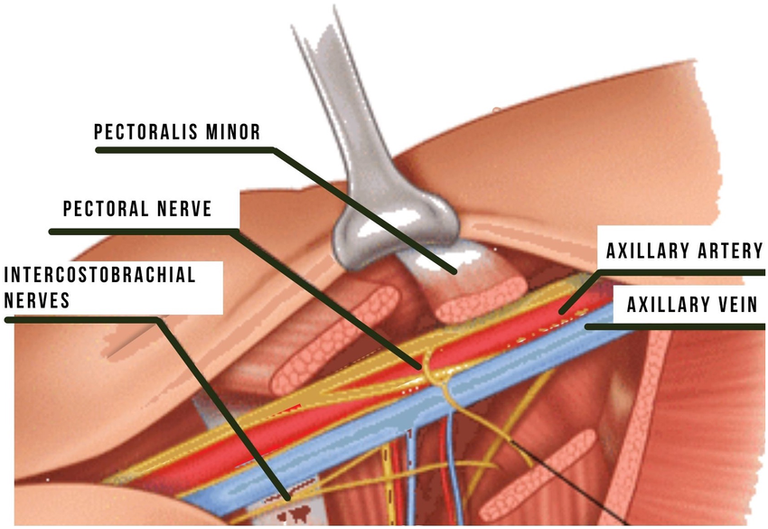Simplifying the Anatomy of the upper limb: Arterial Supply of the shoulder Region
Introduction
As we go about our daily lives, we often don't think about thebnetwork of blood vessels that keep our bodies functioning properly. However, when it comes to the axillary region, understanding the anatomy of the arterial supply is crucial. The axillary region is a complex area of the body located beneath the shoulder joint, and it plays a vital role in the movement and function of our arms.
In this essay, we will explore the anatomy of the arterial supply of the axillary region. By delving into this topic, we can gain a better understanding of how blood flows through this area, supplying oxygen and nutrients to the surrounding tissues. So, let's take a closer look at the arteries that make up the arterial supply of the axillary region and the important role they play in keeping our bodies healthy and functioning properly.
Subclavian Artery

The course of the subclavian artery from its origin to the point where it transitions into the axillary artery is a critical pathway that involves several key anatomical landmarks and structures. Let's explore this journey in detail:
Origin: The subclavian artery originates on the right side of the body from the brachiocephalic trunk, the first branch of the aortic arch. On the left side, the subclavian artery stems directly from the aortic arch. It ascends superiorly and laterally, passing behind the sternoclavicular joint.
First Part (Proximal): The first part of the subclavian artery extends from its origin to the medial border of the scalenus anterior muscle. This segment is relatively short and is located deep in the neck, running posterior to the sternoclavicular joint. It gives off important branches such as the vertebral artery, internal thoracic artery, and thyrocervical trunk.
Second Part (Medial): The second part of the subclavian artery is situated between the anterior and middle scalene muscles. It runs posterior to the scalenus anterior muscle and is relatively fixed in its position. Branches originating from this segment include the costocervical trunk and the dorsal scapular artery.
Third Part (Distal): The third part of the subclavian artery extends from the lateral border of the scalenus anterior muscle to the outer border of the first rib. At this point, the subclavian artery transitions into the axillary artery. This segment gives off branches like the subscapular artery, which further divides into the circumflex scapular artery and thoracodorsal artery, as well as the anterior and posterior humeral circumflex arteries.
Passage under the Clavicle: As the subclavian artery transitions into the axillary artery, it passes beneath the clavicle. This passage under the clavicle exposes the artery to potential compression and other mechanical stresses, especially in cases of trauma or repetitive movements of the shoulder joint.
Relation to Brachial Plexus: Throughout its course, the subclavian artery is closely related to the brachial plexus, which is a network of nerves that innervate the upper extremities. The roots of the brachial plexus lie in close proximity to the subclavian artery in the neck, and variations in the course of the artery can impact the surrounding nerve structures.
Collateral Circulation
The subclavian artery provides a pathway for collateral circulation, especially in cases where there is occlusion or stenosis of other major arteries in the upper extremities. The collateral circulation via branches of the subclavian artery helps maintain blood flow to the arm even when there are blockages in other arteries.
Clinical Relevance
The knowledge course of the subclavian artery is important for healthcare professionals in diagnosing and treating various conditions affecting the upper extremities. In conditions such as thoracic outlet syndrome or subclavian steal syndrome, where there is compression or occlusion of the subclavian artery, knowledge of the artery's course is essential for proper management.
The Axillary artery
The axillary artery is a crucial blood vessel located in the upper extremity, serving as a major conduit for blood flow from the subclavian artery to the brachial artery.

Origin and Course
The axillary artery begins at the lateral border of the first rib as a continuation of the subclavian artery. It extends to the lower border of the teres major muscle, where it transitions into the brachial artery. The axillary artery runs through the axilla or armpit region, giving off several branches along its course.
Segments
The axillary artery can be divided into three segments based on its relationship to the pectoralis minor muscle:
- First (proximal) part: Superior to the pectoralis minor muscle, it gives off branches like the superior thoracic artery.
- Second (deep) part: Posterior to the pectoralis minor muscle, it gives rise to the thoracoacromial artery, lateral thoracic artery, and subscapular artery.
- Third (distal) part: Lateral to the pectoralis minor muscle, it continues as the brachial artery and gives off branches like the circumflex humeral arteries.
Branches
- Superior Thoracic Artery: Arises from the first part of the axillary artery and supplies the first and second intercostal spaces.
- Thoracoacromial Artery: Divides into branches that supply the deltoid, acromial, clavicular, and pectoral regions.
- Lateral Thoracic Artery: Runs along the lateral border of the pectoralis minor muscle, supplying the serratus anterior muscle and nearby tissues.
- Subscapular Artery: Largest branch of the axillary artery, it divides into the circumflex scapular artery and thoracodorsal artery that supply the scapula and surrounding structures.
Relationships
- Veins: The axillary vein accompanies the axillary artery, forming the axillary sheath together. The close proximity of these structures allows for easy access for vascular procedures and catheterizations.
- Nerves: The axillary artery and its branches are closely associated with the brachial plexus, a network of nerves that innervate the shoulder and upper extremity. Understanding the neurovascular relationships in this region is essential for surgical and diagnostic procedures.
- Muscles: The axillary artery runs deep to various muscles in the shoulder region, including the deltoid, teres major, and pectoralis major, highlighting its importance in supplying oxygenated blood to these muscles.
Clinical Significance
Pulse Examination: The axillary artery pulse is an important clinical indicator used to assess blood flow in the upper extremity.
Thoracic Outlet Syndrome: Compression of the axillary artery, often in the context of thoracic outlet syndrome, can lead to symptoms like arm pain, numbness, and weakness.
Arterial Injuries: Trauma to the axillary artery can result in significant bleeding and compromise blood flow to the arm, requiring prompt medical intervention.
Vascular Access: The axillary artery can serve as a site for arterial catheterization, especially in cases where radial or brachial access is not feasible.
In conclusion, the axillary artery is a critical vascular structure in the upper extremity, playing a key role in supplying oxygenated blood to the shoulder, arm, and surrounding tissues. Its branching pattern, relationships with adjacent structures, and clinical relevance make it an essential component of the circulatory system. Understanding the anatomy and function of the axillary artery is paramount for healthcare providers involved in the evaluation and treatment of vascular disorders affecting the upper limb.
Please consult your Atlas textbooks while reading this topic for easy and fast understanding
References
(1) Subclavian artery: Anatomy, branches and mnemonic | Kenhub. https://www.kenhub.com/en/library/anatomy/the-subclavian-artery.
(2) Subclavian artery - Wikipedia. https://en.wikipedia.org/wiki/Subclavian_artery.
(3) Subclavian artery | Radiology Reference Article | Radiopaedia.org. https://radiopaedia.org/articles/subclavian-artery.
(4) en.wikipedia.org. https://en.wikipedia.org/wiki/Subclavian_artery.
(5) Arterial Supply to the Upper Limb - Subclavian - TeachMeAnatomy. https://teachmeanatomy.info/upper-limb/vessels/arteries/.
(6) Subclavian artery | Arteries of the upper limb | Upper Extremity. https://anatomy.app/article/arteries-of-the-upper-limb/subclavian-artery.
(7) Subclavian artery: What Is It, Location, Branches, and More - Osmosis. https://www.osmosis.org/answers/subclavian-artery.
(8) en.wikipedia.org. https://en.wikipedia.org/wiki/Subclavian_artery.


I am a complete beginner who resides in Africa's Western Hemisphere. My name is James, but you may reach out to me through the Facebook page [James Kossy] (https://www.facebook.com/christ.messenger.904) Physics, chemistry, and biology are the three topics that I find most enjoyable. My current studies are taking place at the university level, with the intention of becoming a recognized professional in physiotherapy. I am fascinated by all things technological, and I take pleasure in contributing to the fascinating technological advancements that are taking place throughout the world today. In my spare time, I'd like to learn more about programming and help others with any technical problems they may be having. 💞 ***🌹❤️ Thank you so much to everyone who has supported me thus far. ****💞 At the moment, I don't have the right words to say how much I appreciate all of your help. You never cease to astonish me with your generosity. For me, this has turned into a haven of enjoyment. Thanks to colleagues like you, this has all been possible. You've been a great support for me. Everything you have done for me and my family has been greatly appreciated, and I will always be grateful to you. 💕.
Posted Using InLeo Alpha
Dear @jsalvage !
My bro James!
I admire your excellent medical knowledge!
By the way, I enjoy articles about the lives of you and your family and friends!😄
Hahaha, no problem at all. I'm going to write about myself or friends very soon
I have high expectations!😄
Thanks for your contribution to the STEMsocial community. Feel free to join us on discord to get to know the rest of us!
Please consider delegating to the @stemsocial account (85% of the curation rewards are returned).
You may also include @stemsocial as a beneficiary of the rewards of this post to get a stronger support.
Very interesting topic, I don´t know much about anatomy or medicine, but I would like to learn a little more! Greetings!